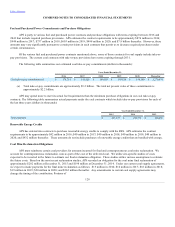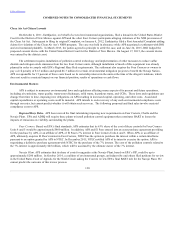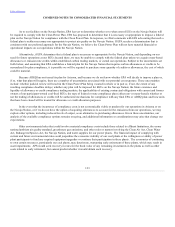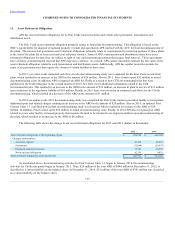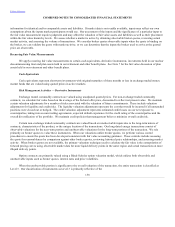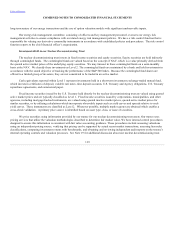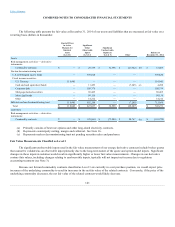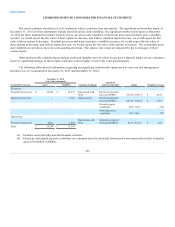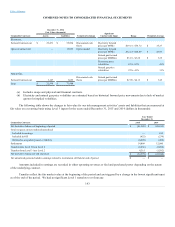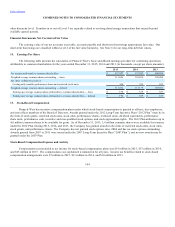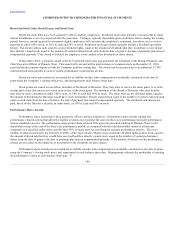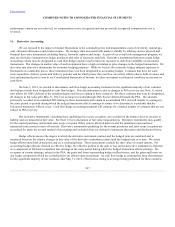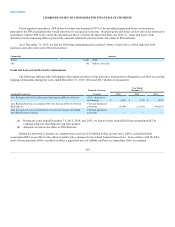APS 2015 Annual Report Download - page 143
Download and view the complete annual report
Please find page 143 of the 2015 APS annual report below. You can navigate through the pages in the report by either clicking on the pages listed below, or by using the keyword search tool below to find specific information within the annual report.
Table of Contents
COMBINED NOTES TO CONSOLIDATED FINANCIAL STATEMENTS
information for identical and/or comparable assets and liabilities. If market data is not readily available, inputs may reflect our own
assumptions about the inputs market participants would use. Our assessment of the inputs and the significance of a particular input to
the fair value measurement requires judgment and may affect the valuation of fair value assets and liabilities as well as their placement
within the fair value hierarchy levels. We assess whether a market is active by obtaining observable broker quotes, reviewing actual
market activity, and assessing the volume of transactions. We consider broker quotes observable inputs when the quote is binding on
the broker, we can validate the quote with market activity, or we can determine that the inputs the broker used to arrive at the quoted
price are observable.
Recurring Fair Value Measurements
We apply recurring fair value measurements to certain cash equivalents, derivative instruments, investments held in our nuclear
decommissioning trust and plan assets held in our retirement and other benefit plans. See Note 7 for the fair value discussion of plan
assets held in our retirement and other benefit plans.
Cash Equivalents
Cash equivalents represent short-term investments with original maturities of three months or less in exchange traded money
market funds that are valued using quoted prices in active markets.
Risk Management Activities — Derivative Instruments
Exchange traded commodity contracts are valued using unadjusted quoted prices. For non-exchange traded commodity
contracts, we calculate fair value based on the average of the bid and offer price, discounted to reflect net present value. We maintain
certain valuation adjustments for a number of risks associated with the valuation of future commitments. These include valuation
adjustments for liquidity and credit risks. The liquidity valuation adjustment represents the cost that would be incurred if all unmatched
positions were closed out or hedged. The credit valuation adjustment represents estimated credit losses on our net exposure to
counterparties, taking into account netting agreements, expected default experience for the credit rating of the counterparties and the
overall diversification of the portfolio. We maintain credit policies that management believes minimize overall credit risk.
Certain non-exchange traded commodity contracts are valued based on unobservable inputs due to the long-term nature of
contracts, characteristics of the product, or the unique location of the transactions. Our long-dated energy transactions consist of
observable valuations for the near-term portion and unobservable valuations for the long-term portions of the transaction. We rely
primarily on broker quotes to value these instruments. When our valuations utilize broker quotes, we perform various control
procedures to ensure the quote has been developed consistent with fair value accounting guidance. These controls include assessing
the quote for reasonableness by comparison against other broker quotes, reviewing historical price relationships, and assessing market
activity. When broker quotes are not available, the primary valuation technique used to calculate the fair value is the extrapolation of
forward pricing curves using observable market data for more liquid delivery points in the same region and actual transactions at more
illiquid delivery points.
Option contracts are primarily valued using a Black-Scholes option valuation model, which utilizes both observable and
unobservable inputs such as broker quotes, interest rates and price volatilities.
When the unobservable portion is significant to the overall valuation of the transaction, the entire transaction is classified as
Level 3. Our classification of instruments as Level 3 is primarily reflective of the
138


